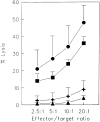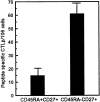Phenotypic and functional separation of memory and effector human CD8+ T cells
- PMID: 9348298
- PMCID: PMC2199103
- DOI: 10.1084/jem.186.9.1407
Phenotypic and functional separation of memory and effector human CD8+ T cells
Abstract
Human CD8+ memory- and effector-type T cells are poorly defined. We show here that, next to a naive compartment, two discrete primed subpopulations can be found within the circulating human CD8+ T cell subset. First, CD45RA-CD45R0(+) cells are reminiscent of memory-type T cells in that they express elevated levels of CD95 (Fas) and the integrin family members CD11a, CD18, CD29, CD49d, and CD49e, compared to naive CD8+ T cells, and are able to secrete not only interleukin (IL) 2 but also interferon gamma, tumor necrosis factor alpha, and IL-4. This subset does not exert cytolytic activity without prior in vitro stimulation but does contain virus-specific cytotoxic T lymphocyte (CTL) precursors. A second primed population is characterized by CD45RA expression with concomitant absence of expression of the costimulatory molecules CD27 and CD28. The CD8+CD45RA+CD27- population contains T cells expressing high levels of CD11a, CD11b, CD18, and CD49d, whereas CD62L (L-selectin) is not expressed. These T cells do not secrete IL-2 or -4 but can produce IFN-gamma and TNF-alpha. In accordance with this finding, cells contained within this subpopulation depend for proliferation on exogenous growth factors such as IL-2 and -15. Interestingly, CD8+CD45RA+CD27- cells parallel effector CTLs, as they abundantly express Fas-ligand mRNA, contain perforin and granzyme B, and have high cytolytic activity without in vitro prestimulation. Based on both phenotypic and functional properties, we conclude that memory- and effector-type T cells can be separated as distinct entities within the human CD8+ T cell subset.
Figures










References
-
- Merkenschlager M, Terry L, Edwards R, Beverley PC. Limiting dilution analysis of proliferative responses in human lymphocyte populations defined by the monoclonal antibody UCHL1: implications for differential CD45 expression in T cell memory formation. Eur J Immunol. 1988;18:1653–1661. - PubMed
-
- Byrne JA, Butler JL, Cooper MD. Differential activation requirements for virgin and memory T cells. J Immunol. 1988;141:3249–3257. - PubMed
-
- Sanders ME, Makgoba MW, June CH, Young HA, Shaw S. Enhanced responsiveness of human memory T cells to CD2 and CD3 receptor-mediated activation. Eur J Immunol. 1989;19:803–808. - PubMed
-
- Picker LJ, Singh MK, Zdraveski Z, Treer JR, Waldrop SL, Bergstresser PR, Maino VC. Direct demonstration of cytokine synthesis heterogeneity among human memory/effector T cells by flow cytometry. Blood. 1995;86:1408–1419. - PubMed
-
- Sanders ME, Makgoba MW, Sharrow SO, Stephany D, Springer TA, Young HA, Shaw S. Human memory T lymphocytes express increased levels of three cell adhesion molecules (LFA-3, CD2, and LFA-1) and three other molecules (UCHL-1, CDw29, and Pgp-1) and have enhanced IFN-γ production. J Immunol. 1988;140:1401–1407. - PubMed
Publication types
MeSH terms
Substances
LinkOut - more resources
Full Text Sources
Other Literature Sources
Research Materials
Miscellaneous

